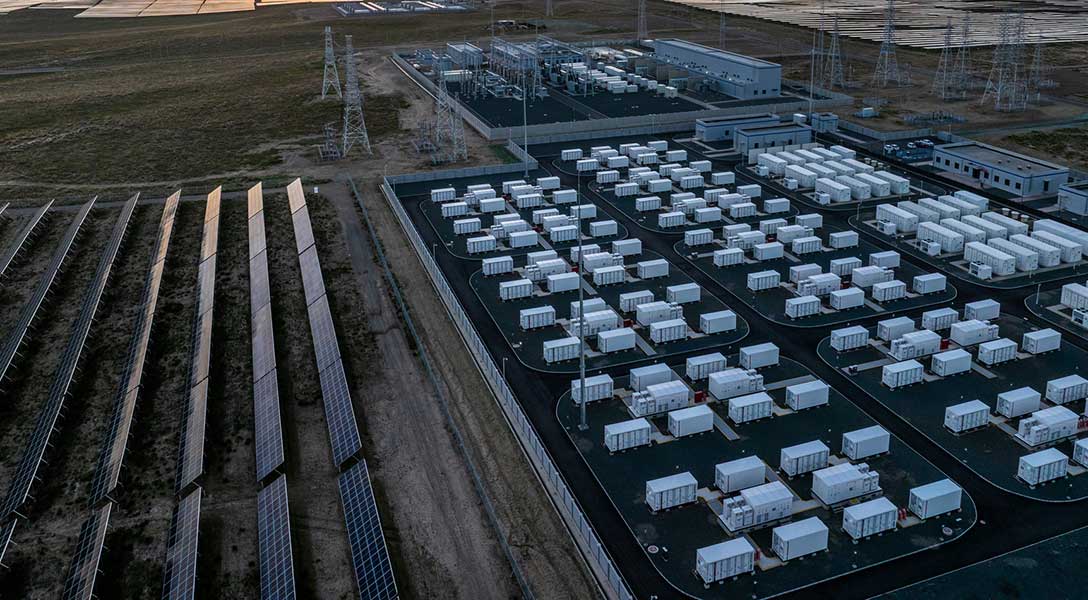
Grading Texas education requires a closer look behind the numbers
The adequacy of the Texas educational system, which enrolls more than 5.5 million children in public kindergarten-through-12 schools, has been a recurring source of concern in the state. By the numbers, Texas lags in key areas when compared with other states and the nation as a whole. But when the data are put into context, reasons for optimism emerge.
Most notably, after adjusting for the state’s unique demographic characteristics, educational attainment in Texas resembles that of the nation. Similarly adjusting test scores shows Texas outperforming most states in K–12 academic performance.
Although public school spending in Texas trails the nation, it has been rising (outpacing inflation) and will increase again under a measure approved by the 2025 Legislature.
However, while Texas high school graduation rates are among the highest in the nation, college graduation rates fall short of the national average, pointing to one of the state’s persistent challenges.
Migration to Texas plays a role when measuring education
Educational attainment is measured by the highest completed level of education. Overall, Texas has a comparatively high share of prime-age (25–54) adults with less than high school diplomas, and a relatively low share of residents with graduate and professional degrees (Chart 1).
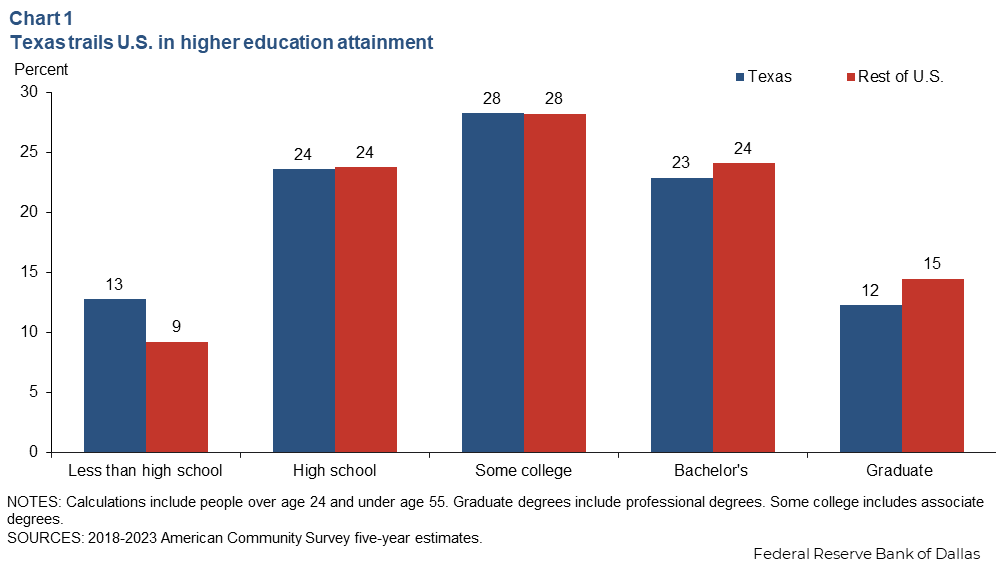
The state boasts a large immigrant population as well as outsized flows of domestic in-migrants. As a result of the former, Texas has an above average share of working-age (over age 16) immigrants—about 22 percent compared with about 17 percent for the U.S. in 2023. Educational attainment levels significantly differ between those born in the U.S. and immigrants (Chart 2).
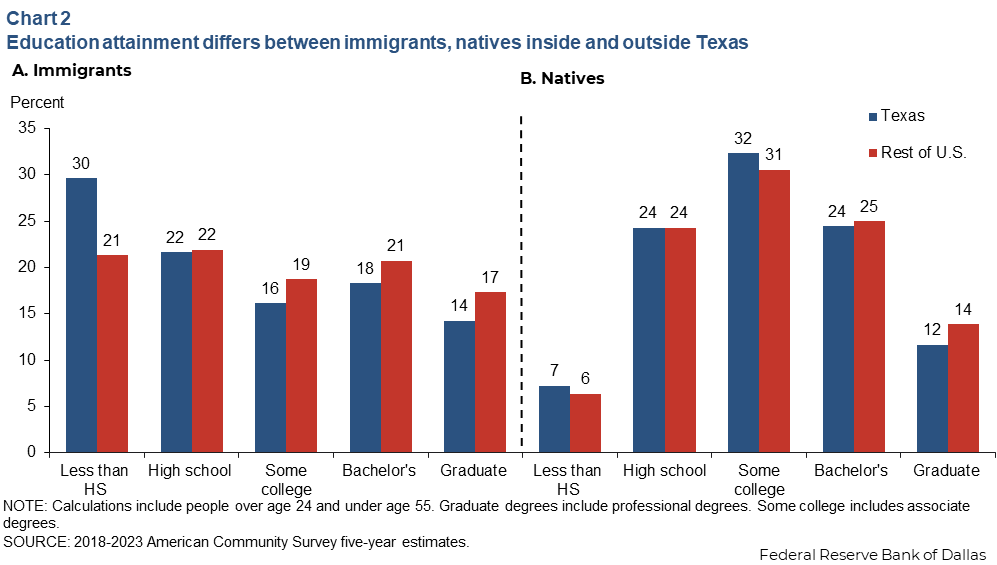
There are also notable differences in educational attainment between immigrants in Texas and immigrants residing in other states. For instance, 30 percent of prime-age immigrants in Texas do not have high school diplomas or GEDs compared with 21 percent of prime-age immigrants in the rest of the U.S. Texas has the second-largest population of immigrants from Mexico, who are comparatively less educated.
However, when considering educational attainment among the U.S.-born, the education distribution looks very similar in and outside Texas, apart from a lower share of adults with graduate and professional degrees. Advanced-degree attainment is comparatively lower in Texas than in the U.S. (12 percent compared with 14 percent) despite significant migration of high-skilled individuals from other states.
Public expenditures for K–12 education trail U.S.
While the numbers of international and domestic migrants in Texas affect the distribution of educational attainment, this distribution is mainly influenced by those native to Texas. For Texans who as adults remain in the state—a notably higher proportion than observed in other states—public expenditures may partially shape their educational outcomes.
Per-pupil annual spending for public primary and secondary schools in Texas, at about $12,300 in 2023, is 26 percent below the national average and 10th worst among all the states, according to the Census Bureau (Chart 3).
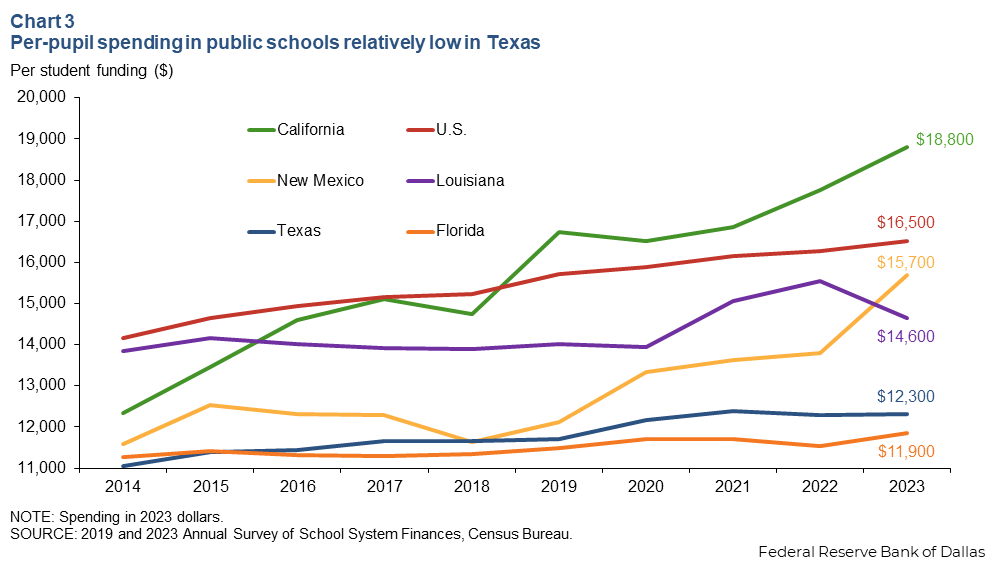
By comparison, the top-spending state, New York (not shown), allocated around $30,000 per pupil in 2023—almost 2 ½ times as much as Texas. Notably, spending levels are not adjusted for cost-of-living differences across states that inflate expenditures in certain regions.
Despite relatively low spending in Texas, public expenditures have risen faster than inflation. Real spending is up about 10 percent in the 10 years through 2023, and state lawmakers recently committed to notable increases in funding for public schools, which should raise state per-pupil funding for public education over the next two years.
However, the federal government has contemplated cutting federal funds for K–12 public schools, which could leave Texas’ per-pupil spending little changed.
Within the Eleventh Federal Reserve District (Texas, southern New Mexico and northern Louisiana), New Mexico has boosted education spending since 2018, when levels were once similar to Texas. The increase followed receipt of additional tax revenue from the state’s growing oil and gas sector.
Public school outcomes detailed
The National Assessment of Educational Progress evaluates public education outcomes by testing students nationwide on math and reading and other subjects in grades four, eight and 12. In what is called the “nation’s report card,” Texas fourth and eighth graders appear to fall short.
Outside of fourth-grade math, the state’s scores suggest student achievement is well below average. Texas ranked 38th in fourth-grade reading, 44th in eighth-grade reading and 34th in eighth-grade math (Table 1).
Table 1
Demographic adjustment boosts Texas student test scores, state ranking
| Rank | |||
| Unadjusted | Adjusted | ||
| 4th grade | Reading | 38th | 9th |
| Math | 8th | 3rd | |
| 8th grade | Reading | 44th | 10th |
| Math | 34th | 6th | |
NOTE: Adjusted scores are calculated using demographic and socioeconomic variables for the state. |
|||
However, after adjusting for differences across states in the characteristics of student populations, the state’s relative performance improves. The Urban Institute, a nonprofit research organization, undertakes such an adjustment, modifying scores for factors such as student age, race, ethnicity and gender. It also considers whether a student is eligible for a free or discounted lunch, is a non-native English speaker or lives in a home where English isn’t commonly spoken.
After these adjustments, which allow for a demographically consistent comparison across states, the quality of Texas’ schools appears substantially better. Indeed, Texas’ schools rank in the top 10 on an adjusted basis in Table 1.
High school graduation rates above U.S. level
Texas also does well when it comes to high school graduation. The state’s nearly 90 percent rate surpasses the national average. Texas outperforms neighboring New Mexico and Louisiana. Moreover, Texas’ graduation rates tend to be high across demographic groups (Chart 4). For example, Black Texans’ graduation rates are comparable to the statewide average and higher than for Black students elsewhere in the nation.
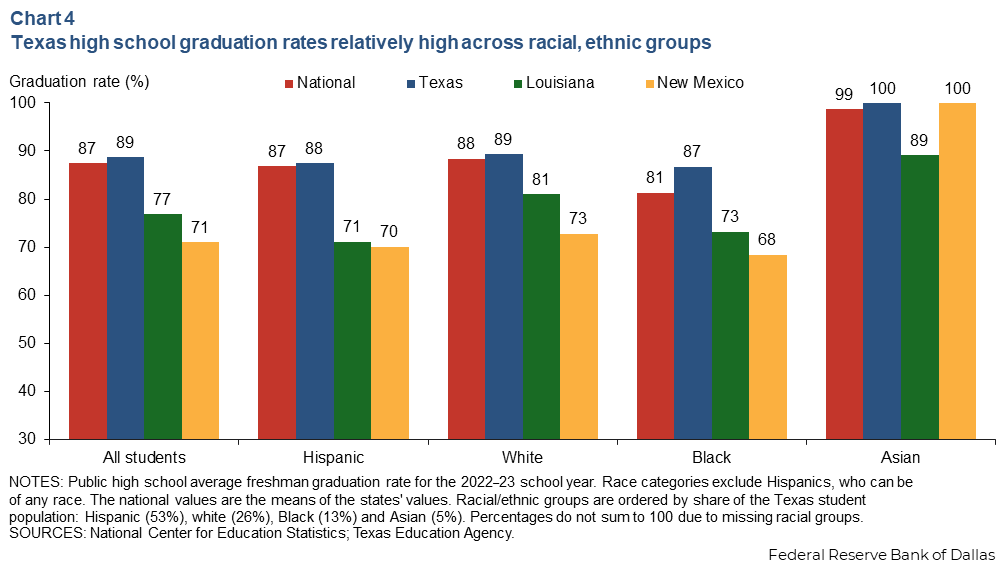
When it comes to graduating from four-year degree-granting public colleges and universities, the story differs. Texas’ six-year college completion rate is 59 percent, 4 percentage points below the U.S. average (Chart 5). The assessment measures the share of students enrolled in fall 2017 and graduating with four-year degrees by 2023.
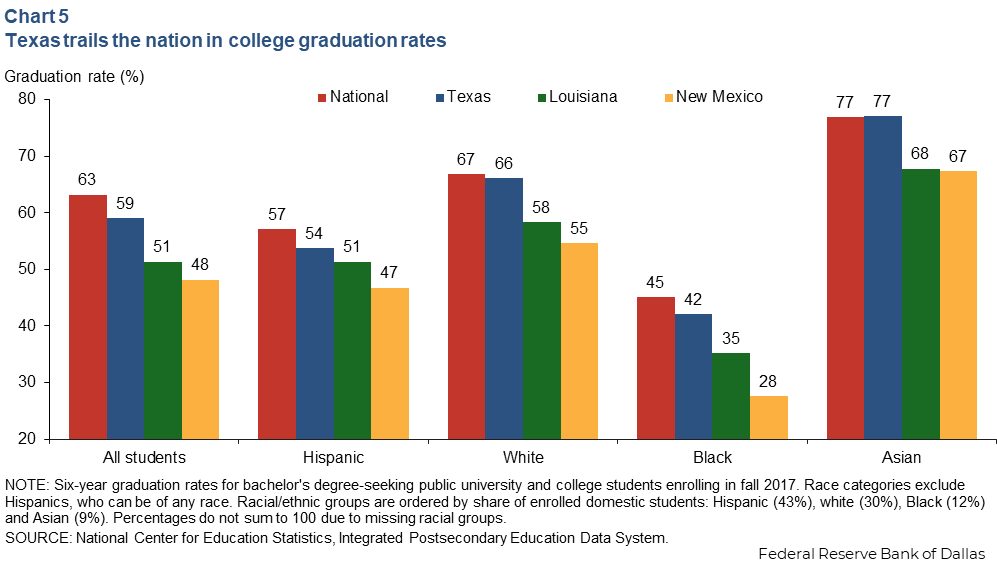
Across demographic groups, the lowest graduation rates are among traditionally disadvantaged groups. In Texas, 54 percent of Hispanic students and 42 percent of Black students at the state’s public universities graduate in six years compared with 66 percent of non-Hispanic whites. Enrollment in these institutions is also lower among these groups. Hispanics make up a majority of K–12 students in Texas, but only 43 percent of students enrolled in four-year public colleges and universities.
A variety of factors influence Hispanic college completion rates, such as lack of college readiness and attendance at universities with lower overall graduation rates. Hispanic students are also more likely to enroll in community college than other students.
Undergraduates who start in community college are less likely to earn their four-year degrees than those enrolling in traditional four-year institutions. That said, Texas community colleges provide a number of other options, such as two-year degrees and certificate programs that directly lead into the workforce.
The state’s lower college graduation rates also likely reflect students entering the workforce before concluding their studies. Foregone earnings is the largest college cost most students encounter. In Texas, a fast-growing economy with plenty of well-paying blue-collar jobs in sectors such as energy, manufacturing and construction provides alternative career pathways.
Research shows, for example, that cohorts of students who came of age during energy booms when wages sharply rose were 1 to 2 percentage points less likely to have college degrees than similar students not exposed to booms.
Setting a goal for greater educational attainment
Texas education leaders have indicated they are aware of the need to increase postsecondary schooling, an objective that would require boosting college completion rates and enrollment. The Texas Higher Education Coordinating Board set a long-run goal of 60 percent of residents ages 25 to 34 possessing postsecondary certificates or degrees by 2030. The board’s 60x30TX plan includes higher postsecondary school completion rates, educational offerings that emphasize marketable skills and limits on student debt.
Investing in the education of the future workforce has broad implications for sustaining economic prosperity and boosting economic growth. Education and training help develop human capital, which is correlated with higher productivity, or more output per worker. Higher education levels also lead to increased income, longevity and better health.
Education has many beneficial spillovers—positive externalities in economic parlance—and individuals tend to underinvest in education if left to their own devices. This is why government has an important role to play in funding schools and students and devising policies that boost educational attainment.
About the authors






